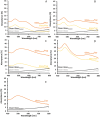Monolayers of Amino Acid-Synthesized Gold Nanoparticles as SERS Substrates for Trace Chemical Sensing
- PMID: 40695729
- PMCID: PMC12333418
- DOI: 10.1021/acs.langmuir.5c01335
Monolayers of Amino Acid-Synthesized Gold Nanoparticles as SERS Substrates for Trace Chemical Sensing
Abstract
In recent years, extensive studies have been devoted to the applications of surface-enhanced Raman spectroscopy (SERS) in detecting and identifying trace amounts of various analytes. The crucial issue for SERS applications is the selection of reliable and reproducible substrates. Therefore, most studies were dedicated to their fabrication, characterization, and evaluation using selected test compounds. This article reports the results of comparative studies on the fabrication, characterization, and evaluation of SERS substrates in the form of monolayers of amino acid-synthesized gold nanoparticles (AuNPs) on silicon and glass platforms. The combination of AuNPs synthesized with five amino acids and four platforms with smooth and rough surfaces yielded 17 potential SERS substrates. SERS substrates and their components were characterized using microscopy and spectroscopy techniques. The SERS performance of fabricated substrates was evaluated using p-mercaptobenzoic acid and 1,2-bis(4-pyridyl)ethylene as test analytes. The studies showed that not all AuNPs synthesized with amino acids are suitable for fabricating efficient SERS-active substrates. The AuNPs' surface chemistry influences the fabrication and performance of SERS substrates. Among the fabricated SERS-active substrates, the highest enhancement factors (EFs) were estimated for those made with l-serine-synthesized AuNPs.
Figures








Similar articles
-
Recent advances in the design of SERS substrates and sensing systems for (bio)sensing applications: Systems from single cell to single molecule detection.F1000Res. 2025 Jun 24;13:670. doi: 10.12688/f1000research.149263.3. eCollection 2024. F1000Res. 2025. PMID: 40255478 Free PMC article. Review.
-
Nanoplasmonic Au-Ag Alloy Coatings on the Surface of TiO2 Nanotubes for Vitamin B12 Detection by Surface-Enhanced Raman Scattering Spectroscopy.ACS Omega. 2025 Jun 12;10(24):25555-25568. doi: 10.1021/acsomega.5c01060. eCollection 2025 Jun 24. ACS Omega. 2025. PMID: 40584309 Free PMC article.
-
The Black Book of Psychotropic Dosing and Monitoring.Psychopharmacol Bull. 2024 Jul 8;54(3):8-59. Psychopharmacol Bull. 2024. PMID: 38993656 Free PMC article. Review.
-
Sexual Harassment and Prevention Training.2024 Mar 29. In: StatPearls [Internet]. Treasure Island (FL): StatPearls Publishing; 2025 Jan–. 2024 Mar 29. In: StatPearls [Internet]. Treasure Island (FL): StatPearls Publishing; 2025 Jan–. PMID: 36508513 Free Books & Documents.
-
Systemic pharmacological treatments for chronic plaque psoriasis: a network meta-analysis.Cochrane Database Syst Rev. 2021 Apr 19;4(4):CD011535. doi: 10.1002/14651858.CD011535.pub4. Cochrane Database Syst Rev. 2021. Update in: Cochrane Database Syst Rev. 2022 May 23;5:CD011535. doi: 10.1002/14651858.CD011535.pub5. PMID: 33871055 Free PMC article. Updated.
References
-
- Panikar S. S., Cialla-May D., De la Rosa E., Salas P., Popp J.. Towards Translation of Surface-Enhanced Raman Spectroscopy (SERS) to Clinical Practice: Progress and Trends. TrAC, Trends Anal. Chem. 2021;134:116122. doi: 10.1016/j.trac.2020.116122. - DOI
LinkOut - more resources
Full Text Sources
Miscellaneous

